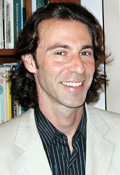UCSF Center for Vulnerable Populations Offers Sustainable Solutions for Diabetes Patients

Dean Schillinger
A UCSF team has found that using a simple communication technology is more effective than traditonal methods in managing diabetes in underserved populations that have communication barriers.
Led by Dean Schillinger, MD, UCSF professor of medicine, director of the UCSF Center for Vulnerable Populations and chief of the California Diabetes Program in the California Department of Public Health, the Improving Diabetes Efforts Across Language and Literacy (IDEALL) study found that using automated telephone technology is more effective in addressing communication barriers such as limited literacy and limited English proficiency.
The IDEALL study was featured in the April 2009 issue of the journal Diabetes Care.
The IDEALL study team developed an automated telephone self-management support system (ATSM) for diabetes management and found that the tool can reduce diabetes-related health disparities in vulnerable populations.
“We were really impressed that diabetes patients with limited literacy and limited English proficiency, who many health care workers consider to be hard to reach, were the most likely to use this communication tool,” said Schillinger. “We found that better communication between a public health care system and the vulnerable populations they serve yielded concrete health benefits.”
Housed at UCSF-affiliated San Francisco General Hospital, the Center for Vulnerable Populations (CVP) is a pioneering venture focused on improving health care for vulnerable populations. CVP’s mission is to carry out innovative research to prevent and treat chronic disease in vulnerable populations, whose chronic disease management is often more challenging.
CVP has distinguished itself as a practice-based research center that has helped translate research into community benefits. Beyond the local communities it serves, CVP is nationally and internationally known for its research in health communication and health policy to reduce health disparities.
Diabetes and Literacy
An estimated 23.6 million people nearly 8 percent of the population of the United States live with diabetes.
Nationally, the number of people diagnosed with type 2 diabetes has doubled over the past decade, an increase the Centers for Disease Control and Prevention calls an epidemic. In California, one out of nine adults is afflicted with diabetes.
Diabetes is more prevalent among those without a high school education and disproportionately affects underserved and ethnically diverse populations, including Latinos, African Americans, Native Americans and Asian Pacific Islanders.
Diabetes control is strongly correlated with educational and literacy levels. This can be attributed to the fact that diabetes self-management relies, in part, on the ability of the patient to read food labels, track blood sugar levels, assess insulin amounts, record meal schedules and communicate with clinicians when complications arise.
The increase of diabetes, coupled with the diverse ethnicities and education levels of Californians, creates an urgent need for linguistically appropriate and cost-effective diabetes management tools accessible to individuals with limited literacy.
“Diabetes requires daily home management by the patient and occasional visits to the clinic,” said Susan Lopez-Payan, coordinator of the California Diabetes Program. “The IDEALL project reaches out to patients in their homes, using an automated telephone call in their native language. It’s so simple, it’s brilliant. Innovative, cost-effective ideas like this show great potential for widespread implementation, saving the state money while improving health outcomes.”
The IDEALL study demonstrates that compared with a group medical visit support system and usual care, ATSM improves communication between patients and providers, facilitates patients’ self-management of their diabetes, and results in significant improvement in physical activity and overall physical and emotional function. It also promotes patient safety and is as cost-effective as other accepted diabetes interventions, such as lipid and blood sugar control.
Luis De Jesus, a San Francisco resident who works two jobs, lacks health insurance and is a monolingual Spanish speaker, participated in the study. De Jesus found the telephone interaction and support he received through the IDEALL study to be far more practical and effective than less frequent in-person visits, he said.
For people like De Jesus, physically going to regularly scheduled appointments with physicians who may or may not speak Spanish is not a practical solution. The IDEALL study allowed patients like De Jesus to manage and control their diabetes through interactions they had with health providers on the phone. Before participating in the study, De Jesus said he felt like “a lost deer in the forest” and believes “this program, without exaggeration, has saved my life.”
“We know that the best way to prevent and control chronic diseases is to address individuals in the larger context of their neighborhoods and communities, and to pay attention to the social determinants of health,” said Linda Rudolph, MD, MPH, deputy director of the Center for Chronic Disease Prevention and Health Promotion in the California Department of Public Health. “This program shows how effective it is to address two of those determinants language and literacy.”
CVP recently received additional federal funding to scale up and adapt ATSM with a local Medi-Cal health plan partner, the San Francisco Health Plan. “The fact that the San Francisco Health Plan is now making this communication tool available to its members who have diabetes suggests that CVP research has practical relevance for key community stakeholders that influence the health of vulnerable populations. That has always been the intent of our research,” said Schillinger.
Related Links:
UCSF Center for Vulnerable Populations
Findings from the UCSF IDEALL Study [PDF]
UCSF Department of Medicine
California Diabetes Program
California Department of Public Health
Simple Tool for Improving Doctor-Patient Communication Yields Significant Health Benefits
UCSF Today, Sept. 27, 2007